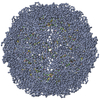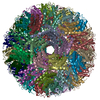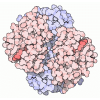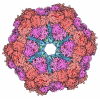+ Open data
Open data
- Basic information
Basic information
| Entry | Database: PDB / ID: 6qcm | |||||||||
|---|---|---|---|---|---|---|---|---|---|---|
| Title | Cryo em structure of the Listeria stressosome | |||||||||
 Components Components |
| |||||||||
 Keywords Keywords | ANTIMICROBIAL PROTEIN / Stressosome complex / stress response machine / Bacteria stress sensor | |||||||||
| Function / homology |  Function and homology information Function and homology information | |||||||||
| Biological species |  Listeria monocytogenes EGD-e (bacteria) Listeria monocytogenes EGD-e (bacteria) | |||||||||
| Method | ELECTRON MICROSCOPY / single particle reconstruction / cryo EM / Resolution: 4.21 Å | |||||||||
 Authors Authors | Williams, A.H. / Redzej, A. / Waksman, G. / Cossart, P. | |||||||||
| Funding support |  United Kingdom, United Kingdom,  France, 2items France, 2items
| |||||||||
 Citation Citation |  Journal: Nat Commun / Year: 2019 Journal: Nat Commun / Year: 2019Title: The cryo-electron microscopy supramolecular structure of the bacterial stressosome unveils its mechanism of activation. Authors: Allison H Williams / Adam Redzej / Nathalie Rolhion / Tiago R D Costa / Aline Rifflet / Gabriel Waksman / Pascale Cossart /   Abstract: How the stressosome, the epicenter of the stress response in bacteria, transmits stress signals from the environment has remained elusive. The stressosome consists of multiple copies of three ...How the stressosome, the epicenter of the stress response in bacteria, transmits stress signals from the environment has remained elusive. The stressosome consists of multiple copies of three proteins RsbR, RsbS and RsbT, a kinase that is important for its activation. Using cryo-electron microscopy, we determined the atomic organization of the Listeria monocytogenes stressosome at 3.38 Å resolution. RsbR and RsbS are organized in a 60-protomers truncated icosahedron. A key phosphorylation site on RsbR (T209) is partially hidden by an RsbR flexible loop, whose "open" or "closed" position could modulate stressosome activity. Interaction between three glutamic acids in the N-terminal domain of RsbR and the membrane-bound mini-protein Prli42 is essential for Listeria survival to stress. Together, our data provide the atomic model of the stressosome core and highlight a loop important for stressosome activation, paving the way towards elucidating the mechanism of signal transduction by the stressosome in bacteria. | |||||||||
| History |
|
- Structure visualization
Structure visualization
| Movie |
 Movie viewer Movie viewer |
|---|---|
| Structure viewer | Molecule:  Molmil Molmil Jmol/JSmol Jmol/JSmol |
- Downloads & links
Downloads & links
- Download
Download
| PDBx/mmCIF format |  6qcm.cif.gz 6qcm.cif.gz | 1.1 MB | Display |  PDBx/mmCIF format PDBx/mmCIF format |
|---|---|---|---|---|
| PDB format |  pdb6qcm.ent.gz pdb6qcm.ent.gz | Display |  PDB format PDB format | |
| PDBx/mmJSON format |  6qcm.json.gz 6qcm.json.gz | Tree view |  PDBx/mmJSON format PDBx/mmJSON format | |
| Others |  Other downloads Other downloads |
-Validation report
| Summary document |  6qcm_validation.pdf.gz 6qcm_validation.pdf.gz | 535.7 KB | Display |  wwPDB validaton report wwPDB validaton report |
|---|---|---|---|---|
| Full document |  6qcm_full_validation.pdf.gz 6qcm_full_validation.pdf.gz | 545 KB | Display | |
| Data in XML |  6qcm_validation.xml.gz 6qcm_validation.xml.gz | 107.4 KB | Display | |
| Data in CIF |  6qcm_validation.cif.gz 6qcm_validation.cif.gz | 179.8 KB | Display | |
| Arichive directory |  https://data.pdbj.org/pub/pdb/validation_reports/qc/6qcm https://data.pdbj.org/pub/pdb/validation_reports/qc/6qcm ftp://data.pdbj.org/pub/pdb/validation_reports/qc/6qcm ftp://data.pdbj.org/pub/pdb/validation_reports/qc/6qcm | HTTPS FTP |
-Related structure data
| Related structure data |  4508MC  4510C M: map data used to model this data C: citing same article ( |
|---|---|
| Similar structure data |
- Links
Links
- Assembly
Assembly
| Deposited unit | 
|
|---|---|
| 1 |
|
- Components
Components
| #1: Protein | Mass: 13944.500 Da / Num. of mol.: 30 Source method: isolated from a genetically manipulated source Source: (gene. exp.)  Listeria monocytogenes EGD-e (bacteria) Listeria monocytogenes EGD-e (bacteria)Gene: RsbR / Production host:  #2: Protein | Mass: 14073.681 Da / Num. of mol.: 6 Source method: isolated from a genetically manipulated source Source: (gene. exp.)  Listeria monocytogenes EGD-e (bacteria) Listeria monocytogenes EGD-e (bacteria)Gene: RsbR / Plasmid: PGEX4T1 / Production host:  #3: Protein | Mass: 12606.707 Da / Num. of mol.: 20 Source method: isolated from a genetically manipulated source Source: (gene. exp.)  Listeria monocytogenes EGD-e (bacteria) Listeria monocytogenes EGD-e (bacteria)Gene: rsbS / Production host:  #4: Protein | | Mass: 13479.988 Da / Num. of mol.: 1 Source method: isolated from a genetically manipulated source Source: (gene. exp.)  Listeria monocytogenes EGD-e (bacteria) Listeria monocytogenes EGD-e (bacteria)Gene: RsbR / Production host:  #5: Protein | Mass: 14860.573 Da / Num. of mol.: 3 Source method: isolated from a genetically manipulated source Source: (gene. exp.)  Listeria monocytogenes EGD-e (bacteria) Listeria monocytogenes EGD-e (bacteria)Gene: RsbR / Production host:  Has protein modification | N | |
|---|
-Experimental details
-Experiment
| Experiment | Method: ELECTRON MICROSCOPY |
|---|---|
| EM experiment | Aggregation state: PARTICLE / 3D reconstruction method: single particle reconstruction |
- Sample preparation
Sample preparation
| Component |
| ||||||||||||||||||||||||||||
|---|---|---|---|---|---|---|---|---|---|---|---|---|---|---|---|---|---|---|---|---|---|---|---|---|---|---|---|---|---|
| Molecular weight | Value: 1.8 MDa / Experimental value: YES | ||||||||||||||||||||||||||||
| Source (natural) |
| ||||||||||||||||||||||||||||
| Source (recombinant) |
| ||||||||||||||||||||||||||||
| Buffer solution | pH: 8.5 | ||||||||||||||||||||||||||||
| Specimen | Conc.: 0.02 mg/ml / Embedding applied: NO / Shadowing applied: NO / Staining applied: NO / Vitrification applied: YES | ||||||||||||||||||||||||||||
| Specimen support | Grid material: COPPER/PALLADIUM / Grid mesh size: 300 divisions/in. / Grid type: Quantifoil R2/2 | ||||||||||||||||||||||||||||
| Vitrification | Instrument: FEI VITROBOT MARK IV / Cryogen name: ETHANE / Humidity: 100 % / Chamber temperature: 277 K |
- Electron microscopy imaging
Electron microscopy imaging
| Experimental equipment |  Model: Titan Krios / Image courtesy: FEI Company |
|---|---|
| Microscopy | Model: FEI TITAN KRIOS |
| Electron gun | Electron source:  FIELD EMISSION GUN / Accelerating voltage: 300 kV / Illumination mode: OTHER FIELD EMISSION GUN / Accelerating voltage: 300 kV / Illumination mode: OTHER |
| Electron lens | Mode: OTHER |
| Specimen holder | Specimen holder model: FEI TITAN KRIOS AUTOGRID HOLDER |
| Image recording | Average exposure time: 10 sec. / Electron dose: 2.25 e/Å2 / Detector mode: COUNTING / Film or detector model: GATAN K2 SUMMIT (4k x 4k) |
| Image scans | Movie frames/image: 20 |
- Processing
Processing
| Software | Name: PHENIX / Version: 1.12_2829: / Classification: refinement | ||||||||||||||||||||||||||||||||||||
|---|---|---|---|---|---|---|---|---|---|---|---|---|---|---|---|---|---|---|---|---|---|---|---|---|---|---|---|---|---|---|---|---|---|---|---|---|---|
| EM software |
| ||||||||||||||||||||||||||||||||||||
| CTF correction | Type: PHASE FLIPPING AND AMPLITUDE CORRECTION | ||||||||||||||||||||||||||||||||||||
| Particle selection | Num. of particles selected: 200000 | ||||||||||||||||||||||||||||||||||||
| Symmetry | Point symmetry: C1 (asymmetric) | ||||||||||||||||||||||||||||||||||||
| 3D reconstruction | Resolution: 4.21 Å / Resolution method: FSC 0.143 CUT-OFF / Num. of particles: 78000 / Num. of class averages: 1 / Symmetry type: POINT | ||||||||||||||||||||||||||||||||||||
| Atomic model building | Protocol: OTHER / Space: REAL | ||||||||||||||||||||||||||||||||||||
| Refine LS restraints |
|
 Movie
Movie Controller
Controller








 PDBj
PDBj








